NR507 final exam .docx/; DOWNLOAD TO SCORE A
Document Content and Description Below
1. Question : NR507 final exam .docx What term is used to describe a hernial protrusion of a saclike cyst that contains meninges, spinal fluid, and a portion of the spinal cord through a defect i... n a posterior arch of a vertebra? Question 2 . Question : What provides the best estimate of the functioning of renal tissue? Question 3 . Question : Where are Langerhans cells found? Question 4 . Question : Where in the lung does gas exchange occur? Question 5 . Question : The tonic neck reflex observed in a newborn should no longer be obtainable by: Question 6 . Question : When renin is released, it is capable of which action? Question 7 . Question : The portion of the antigen that is configured for recognition and binding is referred to as what type of determinant? Question 8 . Question : Which sexually transmitted infection frequently coexists with gonorrhea? Question 9 . Question : How is the effectiveness of vitamin B12 therapy measured? Question 10 . Question : Carcinoma refers to abnormal cell proliferation originating from which tissue origin? Glandular tissue Only cancers arising from epithelial cells are called carcinomas. Question 11 . Question : Which type of microorganism reproduces on the skin? Student Answer: Viruses Bacteria and fungi Protozoa and Rickettsiae Instructor Explanation: Mycoplasma Only bacteria and fungi have the capacity to reproduce on the skin. Question 12 . Question : An infant has a crescendo-decrescendo systolic ejection murmur located between the second and third intercostal spaces along the left sternal border. A wide fixed splitting of the second heart sound is also found. These clinical findings are consistent with which congenital heart defect? Student Answer: Atrial septal defect (ASD) Ventricular septal defect (VSD) Patent ductus arteriosus (PDA) Instructor Explanation: Atrioventricular canal (AVC) defect Because most children with ASD are asymptomatic, diagnosis is usually made during a routine physical examination by the auscultation of a crescendo- decrescendo systolic ejection murmur that reflects increased blood flow through the pulmonary valve. The location of the murmur is between the second and third intercostal spaces along the left sternal border. A wide fixed splitting of the second heart sound is also characteristic of ASD, reflecting volume overload to the right ventricle and causing prolonged ejection time and a delay of pulmonic valve closure. The presentations of other congenital heart defects are not consistent with the described symptoms. Question 13 . Question : An infant diagnosed with a small patent ductus arteriosus (PDA) would likely exhibit which symptom? Student Answer: Intermittent murmur Lack of symptoms Need for surgical repair Instructor Explanation: Triad of congenital defects Infants with a small PDA usually remain asymptomatic; the other options are incorrect. Question 14 . Question : What is the function of erythrocytes? Student Answer: Tissue oxygenation Hemostasis Infection control Instructor Explanation: Allergy response Erythrocytes are solely responsible for tissue oxygenation. Question 15 . Question : Which terms represent the correct nomenclature for benign and malignant tumors of adipose tissue, respectively? Student Answer: Liposarcoma, lipoma Lipoma, liposarcoma Adisarcoma, adipoma Instructor Explanation: Adipoma, adisarcoma In general, cancers are named according to the cell type from which they originate (e.g., lip for cancers that originate in adipose or fat tissue), whereas benign tumors use the suffix -oma. Cancers arising from connective tissue usually have the suffix sarcoma. Question 16 . Question : What is the chance with each pregnancy that a child born to two parents with the sickle trait will have sickle cell disease (SCD)? Student Answer: 20% 25% 33% Instructor Explanation: 50% A 25% chance exists with each pregnancy that a child born to two parents with sickle cell trait will have SCD. Genetic counseling enables people with SCD or with the sickle cell trait to make informed decisions about transmitting this genetic disorder to their offspring. Question 17 . Question : What pulmonary defense mechanism propels a mucous blanket that entraps particles moving toward the oropharynx? Student Answer: Nasal turbinates Alveolar macrophages Cilia Irritant receptors on the nares Instructor Explanation: The submucosal glands of the bronchial lining produce mucus, contributing to the mucous blanket that covers the bronchial epithelium. The ciliated epithelial cells rhythmically beat this mucous blanket toward the trachea and pharynx, where it can be swallowed or expectorated by coughing. This selection is the only option that accurately identifies the pulmonary defense mechanism described. Question 18 . Question : The concentration of the final urine is determined by antidiuretic hormone (ADH), which is secreted by which gland? Student Answer: Posterior pituitary Thyroid Parathyroid Instructor Explanation: Anterior pituitary ADH, which is secreted from the posterior pituitary gland, controls the concentration of the final urine. ADH is not secreted by any of the other options. Question 19 . Question : Why is the herpes virus inaccessible to antibodies after the initial infection? Student Answer: The virus does not circulate in the blood. It does not have antibody receptors. It resists agglutination. Instructor Explanation: The virus is a soluble antigen. Many viruses (e.g., measles, herpes) are inaccessible to antibodies after the initial infection only because these viruses do not circulate in the bloodstream; rather, they remain inside infected cells, spreading by direct cell-to-cell contact. Question 20 . Question : Which renal change is found in older adults? Student Answer: Sharp decline in glomerular filtration rate Sharp decline in renal blood flow Decrease in the number of nephrons Instructor Explanation: Decrease in urine output With aging, the number of nephrons decreases. The other options are not necessarily related to aging. Question 21 . Question : Which immunoglobulin is present in blood, saliva, breast milk, and respiratory secretions? Student Answer: IgA IgE IgG Instructor Explanation: IgM IgA can be divided into two subclasses, IgA1 and IgA2. IgA1 molecules are predominantly found in the blood, whereas IgA2 is the predominant class of antibody found in normal body secretions. The other options are not found in the substances identified in the question. Question 22 . Question : Which hormone prompts increased anxiety, vigilance, and arousal during a stress response? Student Answer: Norepinephrine Epinephrine Cortisol Instructor Explanation: Adrenocorticotropic hormone (ACTH) Only the release of norepinephrine promotes arousal, increased vigilance, increased anxiety, and other protective emotional responses. Question 23 . Question : Which statement is true regarding maternal antibodies provided to the neonate? Student Answer: The antibodies enter into the fetal circulation by means of active transport. The antibodies are transferred to the fetus via the lymphatic system. The antibodies are directly related to the mother’s nutritional intake. Instructor Explanation: The antibodies reach protective levels after approximately 6 months of age. To protect the child against infectious agents both in utero and during the first few postnatal months, a system of active transport facilitates the passage of maternal antibodies into the fetal circulation. The antibodies are transmitted via the placenta and are related to the mother’s immune system. The infant’s own IgG-related antibodies reach protective levels by 6 months of age. Question 24 . Question : The function of the tumor cell marker is to: Student Answer: Provide a definitive diagnosis of cancer. Treat certain types of cancer. Predict where cancers will develop. Instructor Explanation: Screen individuals at high risk for cancer. Screening and identifying individuals at high risk for cancer are ways tumor markers can be used. These markers are not used to definitively diagnosis or treat cancer and are not useful in predicting specific sites of cancer development. Question 25 . Question : Which statement is true concerning a fungal infection? Student Answer: Fungal infections occur only on skin, hair, and nails. Phagocytes and T lymphocytes control fungal infections. Fungal infections release endotoxins. Instructor Explanation: Vaccines prevent fungal infections. The host defense against fungal infection includes the fungistatic properties of neutrophils and macrophages. T lymphocytes are crucial in limiting the extent of infection and producing cytokines to further activate macrophages. The other options are not true of fungal infections. Question 26 . Question : Which change is a result of puberty and defends the vagina from infection? Student Answer: The pH stabilizes between 7 and 8. A thin squamous epithelial lining develops. Vaginal pH becomes more acidic. Instructor Explanation: Estrogen levels are low. At puberty, the pH becomes more acidic (4 to 5) and the squamous epithelial lining thickens. These changes are maintained until menopause (cessation of menstruation), at which time the pH rises again to more alkaline levels and the epithelium thins out. Therefore protection from infection is greatest during the years when a woman is most likely to be sexually active. Estrogen does not play a role in infection protection. Question 27 . Question : The number of persons living with a specific disease at a specific point in time is referred to by which term? Student Answer: Relativity Survivability Prevalence Instructor Explanation: Incidence The prevalence rate is the proportion of the population affected by a disease at a specific point in time. Thus both the incidence rate and the length of the survival period in affected individuals determine prevalence. The description in the question does not relate to any of the other options. Question 28 . Question : Which risk factor for hypertension is influenced by genetic factors and lifestyle? Student Answer: Sodium intake Physical inactivity Psychosocial stress Instructor Explanation: Obesity The most important environmental risk factors for hypertension are increased sodium intake, decreased physical activity, psychosocial stress, and obesity. However, obesity is, itself, influenced by genes and the environment. Question 29 . Question : Having ejected a mature ovum, the ovarian follicle develops into a(n): Student Answer: Atretic follicle Thecal follicle Corpus luteum Instructor Explanation: Functional scar Having ejected a mature ovum, the only resulting structure is the corpus luteum. Question 30 . Question : The failure of bones to ossify, resulting in soft bones and skeletal deformity, characterizes which disorder? Student Answer: Osteogenesis imperfecta Rickets Osteochondrosis Instructor Explanation: Legg-Calvé-Perthes disease Of the available options, only rickets is a disorder in which growing bone fails to become mineralized (ossified) and results in soft bones and skeletal deformity. Question 31 . Question : What is the term that denotes the duration of time or the intensity of pain that a person will endure before outwardly responding? Student Answer: Tolerance Perception Threshold Instructor Explanation: Dominance Pain tolerance is the duration of time or the intensity of pain that an individual will endure before initiating overt pain responses. The other options are not related to the duration or intensity of pain endured before the pain is recognized. Question 32 . Question : Aldosterone directly increases the reabsorption of: Student Answer: Magnesium Calcium Sodium Instructor Explanation: Water In the kidney, aldosterone primarily acts on the epithelial cells of the nephron- collecting duct to increase sodium ion reabsorption. This action cannot be said of the other options. Question 33 . Question : Atrial fibrillation, rheumatic heart disease, and valvular prosthetics are risk factors for which type of stroke? Student Answer: Hemorrhagic Thrombotic Embolic Instructor Explanation: Lacunar High-risk sources for the onset of embolic stroke are atrial fibrillation (15% to 25% of strokes), left ventricular aneurysm or thrombus, left atrial thrombus, recent myocardial infarction, rheumatic valvular disease, mechanical prosthetic valve, nonbacterial thrombotic endocarditis, bacterial endocarditis, patent foramen ovale, and primary intracardiac tumors. These are not risk factors for the other options provided. Question 34 . Question : Which clinical manifestations are associated with fibromyalgia? Student Answer: Hot, tender, and edematous muscle groups bilaterally Fasciculations of the upper and lower extremity muscles Exercise intolerance and painful muscle cramps Instructor Explanation: Sensitivity at tender points and profound fatigue Widespread joint and muscle pain, fatigue, and tender points are characteristics of fibromyalgia, a chronic musculoskeletal syndrome. Increased sensitivity to touch (i.e., tender points), the absence of systemic or localized inflammation, and fatigue and sleep disturbances are common. Fatigue is profound. The remaining options include symptoms not generally associated with fibromyalgia. Question 35 . Question : Prolonged high environmental temperatures that produce dehydration, decreased plasma volumes, hypotension, decreased cardiac output, and tachycardia cause which disorder of temperature regulation? Student Answer: Heat cramps Heat stroke Malignant hyperthermia Instructor Explanation: Heat exhaustion Of the options presented, only heat exhaustion, or collapse, is a result of prolonged high core or environmental temperatures resulting in dehydration, decreased plasma volumes, hypotension, decreased cardiac output, and tachycardia. Question 36 . Question : What is the leading cause of infertility in women? Student Answer: Pelvic inflammatory disease Endometriosis Salpingitis Instructor Explanation: Polycystic ovary syndrome Polycystic ovary syndrome remains one of the most common endocrine disturbances affecting women, especially young women, and is a leading cause of infertility in the United States. Question 37 . Question : Which substance is a water-soluble protein hormone? Student Answer: Thyroxine Aldosterone Follicle-stimulating hormone Instructor Explanation: Insulin Peptide or protein hormones, such as insulin, pituitary, hypothalamic, and parathyroid, are water soluble and circulate in free (unbound) forms. All the remaining options are fat-soluble hormones. Question 38 . Question : What is the target tissue for prolactin-releasing factor? Student Answer: Hypothalamus Anterior pituitary Mammary glands Instructor Explanation: Posterior pituitary Prolactin-releasing factor targets the anterior pituitary gland to stimulate the secretion of prolactin. The other remaining options are incorrect. Question 39 . Question : What is the cause of familial hypercholesterolemia (FH)? Student Answer: Diet high in saturated fats Increased production of cholesterol by the liver Reduction in the number of low-density lipoprotein (LDL) receptors on cell surfaces Abnormal function of lipoprotein receptors circulating in the blood Instructor Explanation: A reduction in the number of functional LDL receptors on cell surfaces causes FH. Lacking the normal number of LDL receptors, cellular cholesterol uptake is reduced and circulating cholesterol levels increase (see Box 5-3). The other options are not the basis for developing familial FH. Question 40 . Question : Regarding type 2 diabetes, obesity is considered to be what type of risk? Student Answer: Genetic Empirical Relative Instructor Explanation: Modifiable Obesity is a modifiable risk factor for many diseases including heart disease, stroke, hypertension, and type 2 diabetes. The other terms do not apply. Question 41 . Question : Which four-step process correctly describes muscle contraction? Student Answer: Coupling, contraction, relaxation, excitation Contraction, relaxation, excitation, coupling Relaxation, excitation, coupling, contraction Instructor Explanation: Excitation, coupling, contraction, relaxation Muscle contraction is a four-step process: excitation, coupling, contraction, and relaxation. Question 42 . Question : Adoption studies have shown that the offspring of an alcoholic parent when raised by nonalcoholic parents have what amount of an increased risk of developing alcoholism? Student Answer: Twofold Threefold Fourfold Instructor Explanation: Tenfold Adoption studies have shown that the offspring of an alcoholic parent, even when raised by nonalcoholic parents, have a fourfold increased risk of developing the disorder. Question 43 . Question : Which hormone stimulates gonads to produce both male and female hormones? Student Answer: Gonadotropin-releasing hormone (GnRH) Follicle-stimulating hormone (FSH) Luteinizing hormone (LH) Instructor Explanation: Estrogen Extrahypothalamic factors cause the hypothalamus to secrete GnRH, which stimulates the anterior pituitary to secrete gonadotropins—FSH and LH. These hormones, in turn, stimulate the gonads (ovaries or testes) to secrete female or male sex hormones. Question 44 . Question : A person with 47, XXY karyotype has the genetic disorder resulting in which syndrome? Student Answer: Turner Klinefelter Down Instructor Explanation: Fragile X A disorder in the chromosome (47, XXY karyotype) results in a disorder known as Klinefelter syndrome. The correct option is the only one that accurately describes a genetic disorder that exhibits the described genetic configuration. Question 45 . Question : Which would be considered a positive symptom of schizophrenia? Student Answer: Blunted affect Auditory hallucinations Poverty of speech Lack of social interaction Instructor Explanation: Positive symptoms frequently occur during a psychotic episode, when an individual loses touch with reality and experiences something that should be absent (e.g., hallucinations). The remaining options are classified as negative symptoms. Question 46 . Question : What term describes the loss of the comprehension or production of language? Student Answer: Agnosia Aphasia Akinesia Instructor Explanation: Dysphasia Aphasia is the loss of the comprehension or production of language. The remaining options are not terms used to describe this loss of function. Question 47 . Question : Consanguinity refers to the mating of persons: Student Answer: Who are unrelated When one has an autosomal dominant disorder Having common family relations Instructor Explanation: When one has a chromosomal abnormality Consanguinity refers to the mating of two related individuals, and the offspring of such matings are said to be inbred. The correct option is the only one that accurately identifies consanguinity as it relates to human mating. Question 48 . Question : The major sleep center is located in which section of the brain? Student Answer: Thalamus Brainstem Frontal lobe Instructor Explanation: Hypothalamus A small group of hypothalamic nerve cells, the suprachiasmatic nucleus (SCN), controls the timing of the sleep-wake cycle and coordinates this cycle with circadian rhythms (24-hour rhythm cycles) in areas of the brain and other tissues. The remaining options do not fulfill this objective. Question 49 . Question : Which type of ion directly controls the contraction of muscles? Student Answer: Sodium Potassium Calcium Instructor Explanation: Magnesium Contraction begins as the calcium ions combine with troponin, a reaction that overcomes the inhibitory function of the troponin-tropomyosin system. This selection is the only option that has such a direct association with muscle contraction. Question 50 . Question : Bacteria gain access to the female urinary tract by which means? Student Answer: Systemic blood that is filtered through the kidney Bacteria traveling from the lymph adjacent to the bladder and kidneys Bacteria ascending the urethra into the bladder Instructor Explanation: Colonization of the bladder when urine is static Urinary tract infections (UTIs) in girls occur as a result of perineal bacteria, especially Escherichia coli, ascending the urethra. None of the other options represent the means by which bacteria gain access to the female urinary tract. Question 51 . Question : A criterion for a diagnosis of generalized anxiety disorder (GAD) is a period of excessive worrying that lasts for at least how many months? Student Answer: 3 6 9 Instructor Explanation: 12 GAD is diagnosed when an individual spends at least 6 months worrying excessively and exhibits at least three of the six symptoms. Although 3 months is not sufficient time, the remaining options are excessive. Question 52 . Question : What is the first indication of nephrotic syndrome in children? Student Answer: Periorbital edema Scrotal or labial edema Frothy urine Instructor Explanation: Ascites Onset of nephritic syndrome is insidious, with periorbital edema as the first sign of the disorder. None of the other options represent the first indication of nephritic syndrome in children. Question 53 . Question : An amniocentesis indicates a neural tube defect when an increase in which protein is evident? Student Answer: Chorionic Alpha fetoprotein Amniotic Instructor Explanation: Embryonic Other disorders can be detected with this procedure. These include most neural tube defects, which cause an elevation of alpha fetoprotein in the amniotic fluid, and hundreds of diseases caused by mutations of single genes. The correct option is the only one that accurately identifies the protein responsible for a neural tube defect. Question 54 . Question : What is the risk for the recurrence of autosomal dominant diseases? Student Answer: 10% 30% 50% Instructor Explanation: 70% The recurrence risk for autosomal dominant diseases is usually 50%. Question 55 . Question : Which term is used to identify the temporary displacement of two bones causing the bone surfaces to partially lose contact? Student Answer: Dislocation Subluxation Malunion Instructor Explanation: Nonunion Dislocation is the temporary displacement of a bone from its normal position in a joint. If the contact between the two surfaces is only partially lost, then the injury is referred to as a subluxation. This selection is the only option that identifies the temporary displacement of two bones, causing the bone surfaces to partially lose contact. Question 56 . Question : The tear in a ligament is referred to as a: Student Answer: Fracture Strain Disunion Instructor Explanation: Sprain Ligament tears are commonly known as sprains. None of the other options are associated with this damage. Question 57 . Question : Why is prolonged diarrhea more severe in children than it is in adults? Student Answer: Less water is absorbed from the colon in children. Fluid reserves are smaller in children. Children have a higher fluid volume intake. Instructor Explanation: Children have diarrhea more often than adults. Infants have low fluid reserves and relatively rapid peristalsis and metabolism. Therefore the danger of dehydration is great. This selection is the only option that correctly identifies the reason prolonged diarrhea is more severe in children. Question 58 . Question : The BRCA1 and BRCA2 mutations increase the risk of which cancer in women? Student Answer: Ovarian Lung Uterine Instructor Explanation : Pancreatic BRCA1 mutations increase the risk of ovarian cancer among women (20% to 50% lifetime risk), and BRCA2 mutations also confer an increased risk of ovarian cancer (10% to 20% lifetime prevalence). BRCA1 and BRCA2 mutations are not currently believed to be linked with risks of lung, uterine, or pancreatic cancers. Question 59 . Question : Insulin transports which electrolyte in the cell? Student Answer: Potassium Calcium Sodium Instructor Explanation: Phosphorus Insulin facilitates the intracellular transport of potassium, phosphate, and magnesium. Insulin does not facilitate the transport of the other electrolytes. Question 60 . Question : What term is used to identify an interlacing bundle of dense, white fibrous tissue that is richly supplied with nerves, blood vessels, and lymphatic vessels? Student Answer: Procallus Joint capsule Hematoma Instructor Explanation: Elastin fibers The joint capsule is made up of parallel, interlacing bundles of dense, white fibrous tissue. It is richly supplied with nerves, blood vessels, and lymphatic vessels. None of the other options are associated with this structure. Question 61 . Question : Which of the following is a lipid-soluble hormone? Student Answer: Cortisol Oxytocin Epinephrine Instructor Explanation: Growth hormone Cortisol and adrenal androgens are lipid-soluble hormones and are primarily bound to a carrier or transport protein in circulation. The other options are water- soluble hormones. Question 62 . Question : The mucosal secretions of the cervix secrete which immunoglobulin? Student Answer: IgA IgE IgG Instructor Explanation: IgM Mucosal secretions from the cervix contain enzymes and antibodies— predominantly IgA. Question 63 . Question : The sudden apparent arousal in which a child expresses intense fear or another strong emotion while still in a sleep state characterizes which sleep disorder? Student Answer: Night terrors Insomnia Somnambulism Instructor Explanation: Enuresis Three types of parasomnias include arousal disorders such as confusional arousals, sleepwalking (somnambulism), and night terrors (dream anxiety attacks). The remaining options do not involve a sense or expression of fear or any other strong emotion. Question 64 . Question : What is the basic structural unit in compact bone? Student Answer: Small channels called canaliculi Osteocytes within the lacunae Tiny spaces within the lacunae Haversian system Instructor Explanation: The basic structural unit in compact bone is the haversian system (see Figure 43-4). This selection is the only option that accurately identifies the basic structure of compact bone. Question 65 . Question : Parkinson disease is a degenerative disorder of the brain’s: Student Answer: Hypothalamus Anterior pituitary Frontal lobe Instructor Explanation: Basal ganglia Parkinson disease is a commonly occurring degenerative disorder of the basal ganglia and not of any of the other brain structures. Question 66 . Question : Which pain theory proposes that a balance of impulses conducted from the spinal cord to the higher centers in the central nervous system (CNS) modulates the transmission of pain? Student Answer: GCT Pattern theory Specificity theory Instructor Explanation: Neuromatrix theory Only the gate control theory (GCT) explains that a balance of impulses conducted to the spinal cord, where cells in the substantia gelatinosa function as a spinal gate, regulates pain transmission to higher centers in the CNS. Question 67 . Question : Saliva contains which immunoglobulin (Ig)? Student Answer: IgA IgE IgG Instructor Explanation: IgM Saliva contains only IgA, which helps prevent infection. Question 68 . Question : What type of fracture occurs at a site of a preexisting bone abnormality and is a result of a force that would not normally cause a fracture? Student Answer: Idiopathic Incomplete Pathologic Instructor Explanation: Greenstick Only a pathologic fracture is a break at the site of a preexisting abnormality, usually by force that would not fracture a normal bone. Question 69 . Question : An infant suddenly develops abdominal pain, becomes irritable (colicky), and draws up the knees. Vomiting occurs soon afterward. The mother reports that the infant passed a normal stool, followed by one that looked like currant jelly. Based on these data, which disorder does the nurse suspect? Student Answer: Congenital aganglionic megacolon Intussusception Malrotation Instructor Explanation: Volvulus Based on these data, the nurse should suspect intussusception. A single normal stool may be passed, evacuating the colon distal to the apex of the intussusception. After passing a normal stool, 60% of infants will pass “currant jelly” stools, which appear dark and gelatinous because of their blood and mucus content. Intussusception is the only option that describes the symptoms listed. Question 70 . Question : In 95% of children of delayed puberty, the problem is caused by: Student Answer: Disruption in the hypothalamus Disruption of the pituitary Deficit in estrogen or testosterone Instructor Explanation: Physiologic hormonal delays In 95% of children with delayed puberty, the delay is physiologic; that is, hormonal levels are normal and the hypothalamic-pituitary-gonadal (HPG) axis is intact, but maturation is slowly happening. This option is the only answer that accurately describes the most common cause of delayed puberty. Question 71 . Question : Which characteristic is true of type II (white fast-motor) muscle fibers? Student Answer: Slow contraction speed Fast conduction velocities Profuse capillary supply Oxidative metabolism Instructor Explanation: Type II fibers, also called white fast-motor fibers, are innervated by relatively large type II alpha motor neurons with fast conduction velocities. This selection is the only correct option provided. Question 72 . Question : Neurofibrillary tangles characterize which neurologic disorder? Student Answer: Dementia syndrome Delirium Alzheimer disease Instructor Explanation: Parkinson disease Amyloid plaques, neurofibrillary tangles, as well as neuronal and synaptic losses in the brain, characterize Alzheimer disease. Question 73 . Question : Which hormone triggers uterine contractions? Student Answer: Thyroxine Oxytocin Growth hormone Instructor Explanation: Insulin Oxytocin is responsible for the contraction of the uterus and milk ejection in lactating women and may affect sperm motility in men. The remaining options are not capable of triggering uterine contractions. Question 74 . Question : How does the release (increase) of epinephrine raise body temperature? Student Answer: The release of epinephrine causes shivering. It affects muscle tone. It raises the metabolic rate. Instructor Explanation: It increases and strengthens the heart rate. Epinephrine and norepinephrine produce a rapid transient increase in heat production by raising the body’s basal metabolic rate. The other options are not correct descriptions of the effects of epinephrine on body heat. Question 75 . Question : Which hormone is linked to an increase in appetite during puberty? Student Answer: Inhibin Leptin Activin Instructor Explanation: Follistatin Sensitivity to leptin, which regulates appetite and energy metabolism, increases during puberty; in theory, the adolescent consumes more calories to meet the caloric needs of the pubertal growth spurt. The percent of body fat and leptin levels in girls continue to increase, whereas muscle mass increases in boys. No apparent link exists between increased appetite during puberty and any of the other options. [Show More]
Last updated: 1 year ago
Preview 1 out of 183 pages
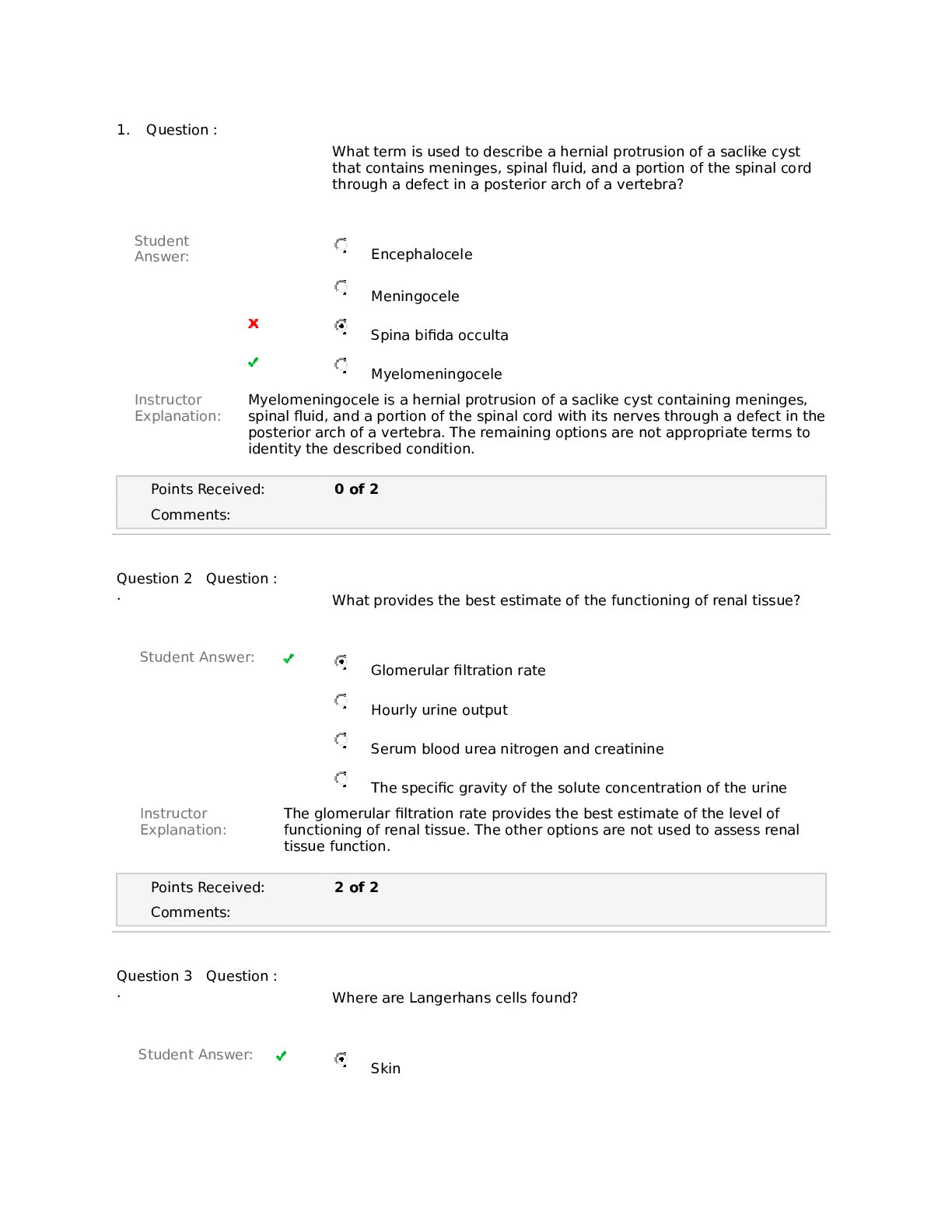
Reviews( 0 )
Document information
Connected school, study & course
About the document
Uploaded On
Jul 23, 2021
Number of pages
183
Written in
Additional information
This document has been written for:
Uploaded
Jul 23, 2021
Downloads
0
Views
57


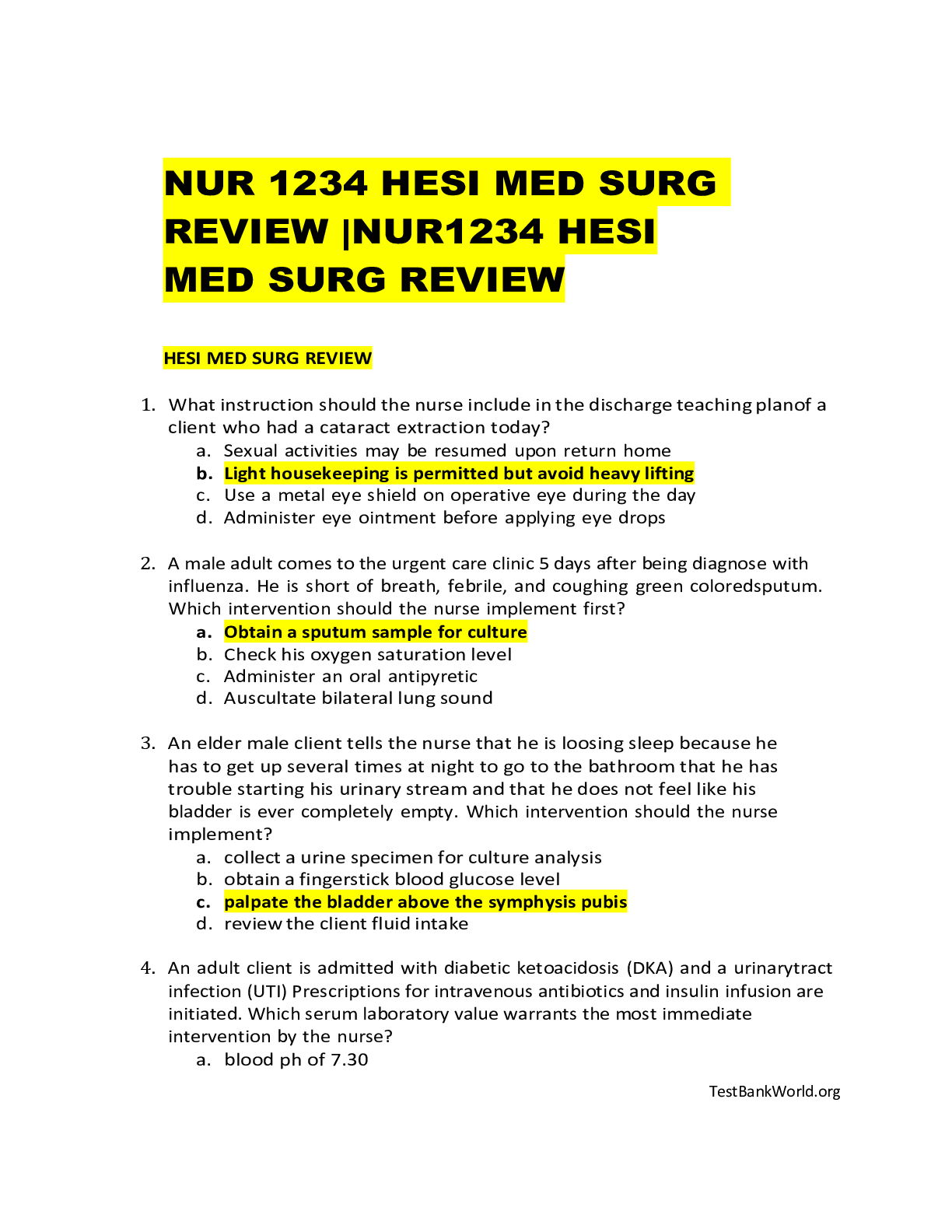


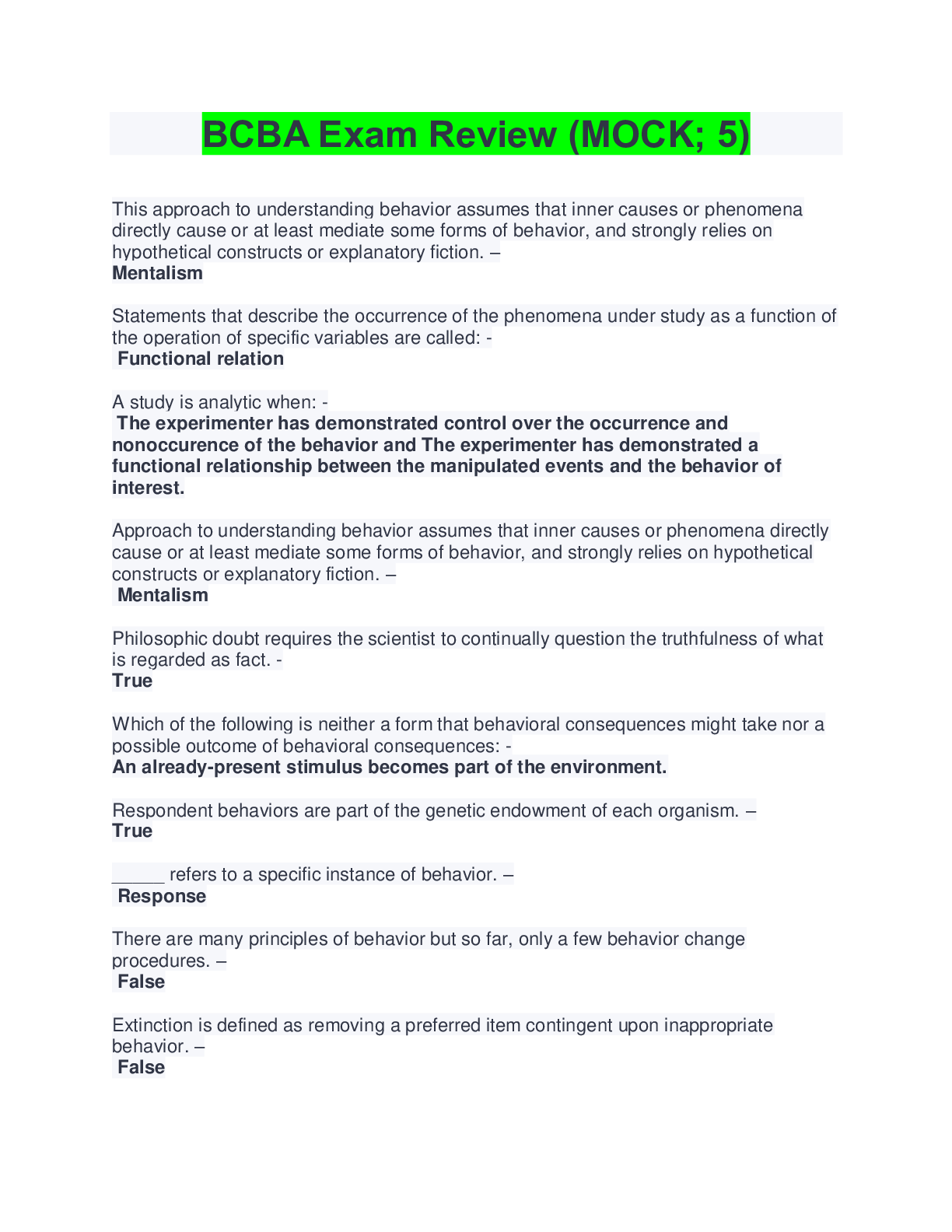

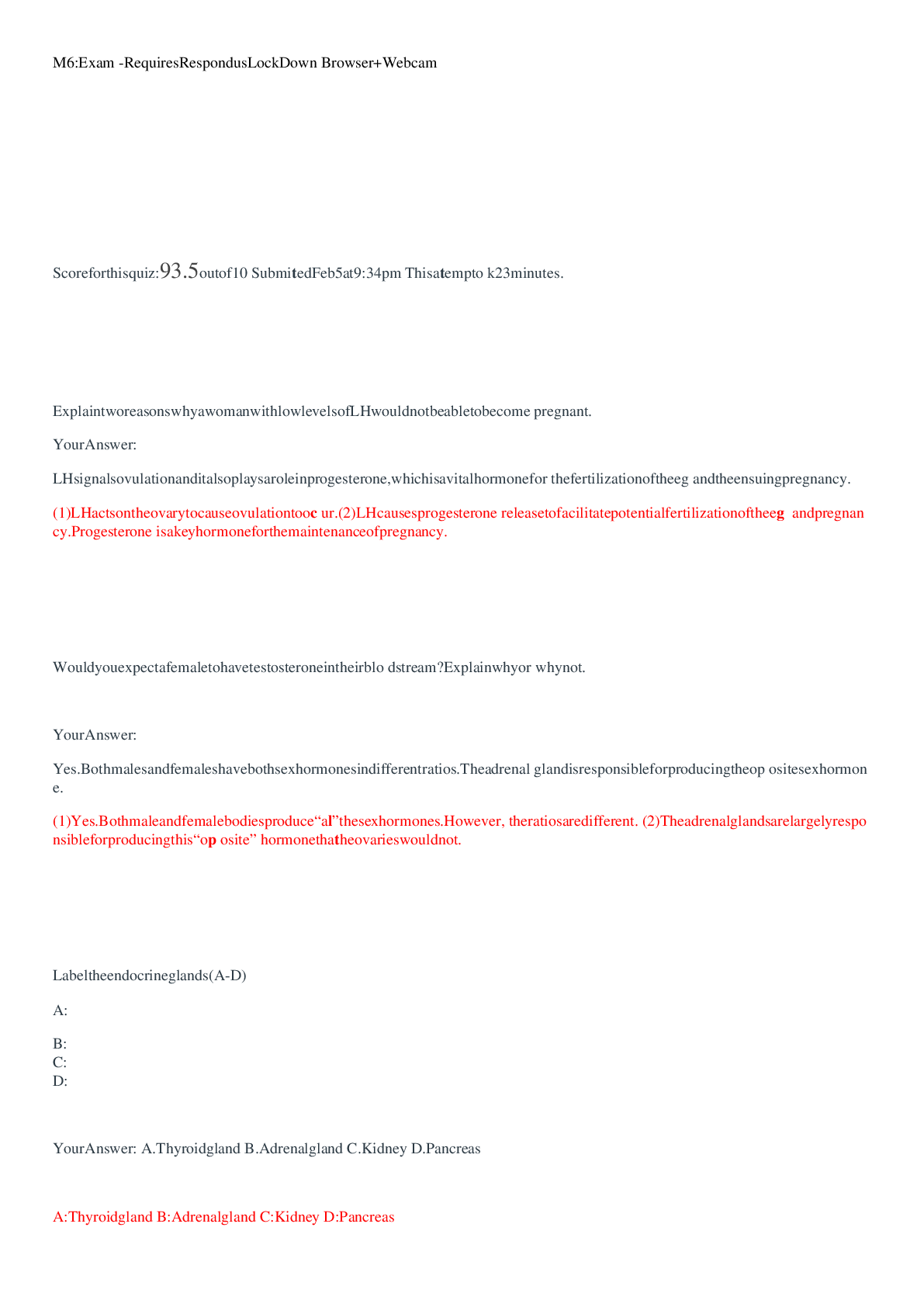
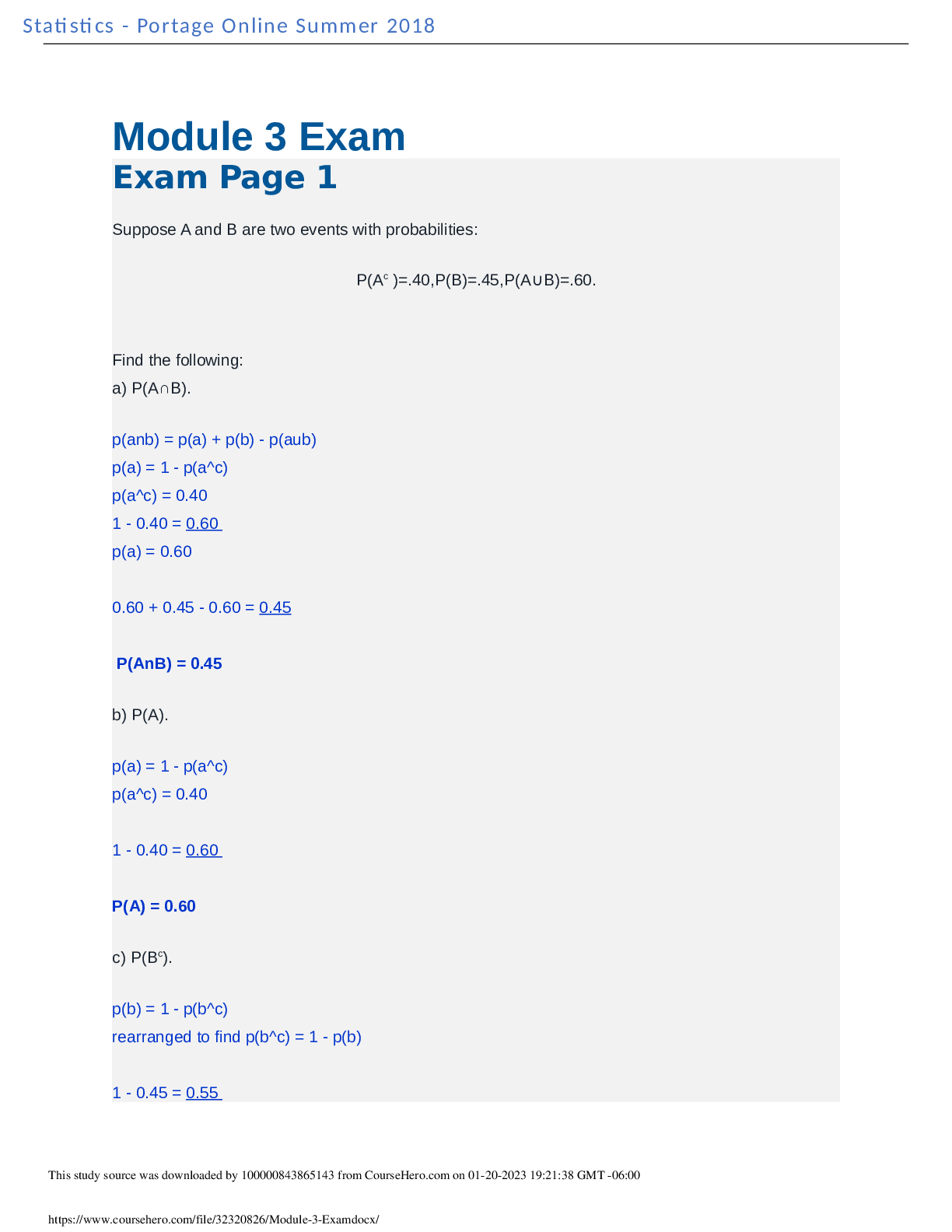
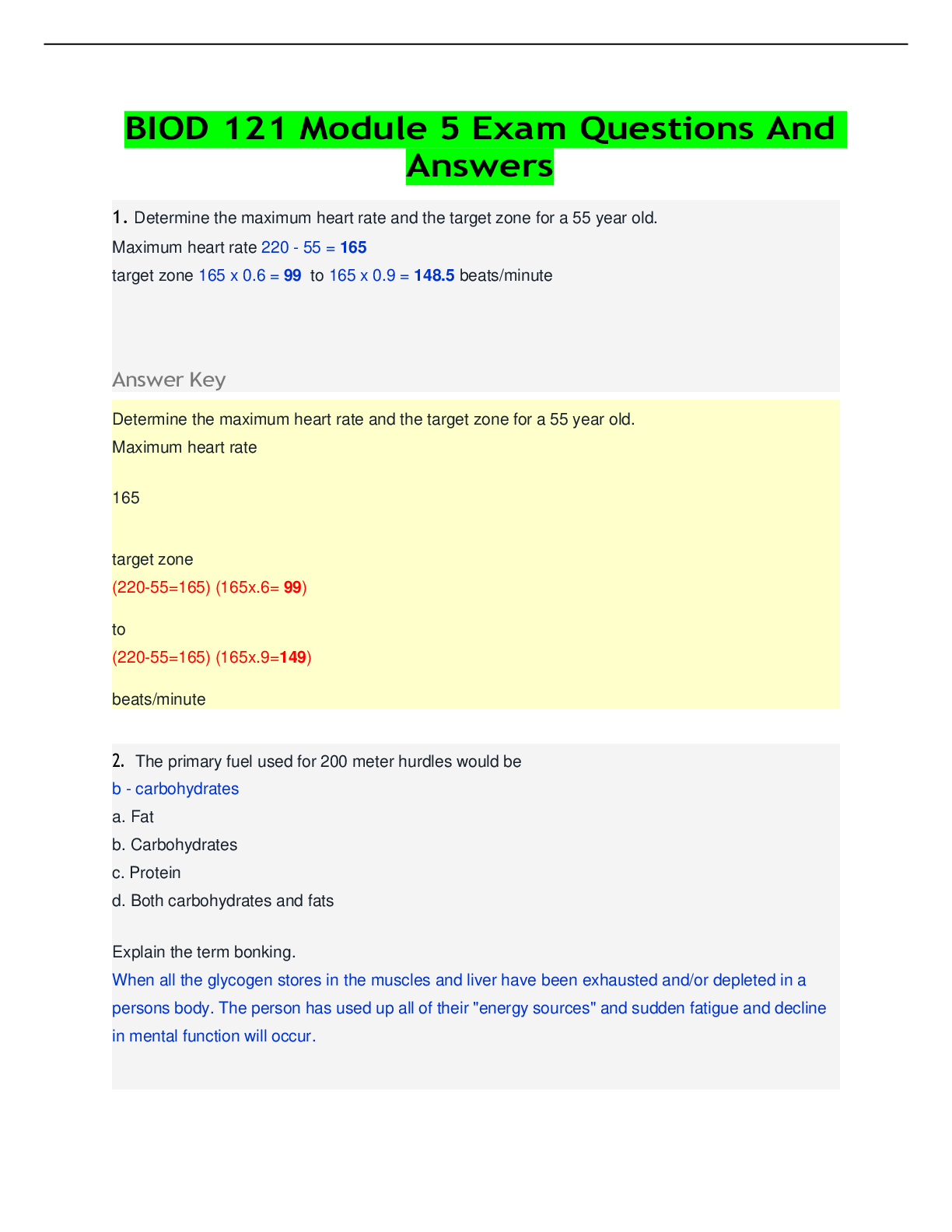
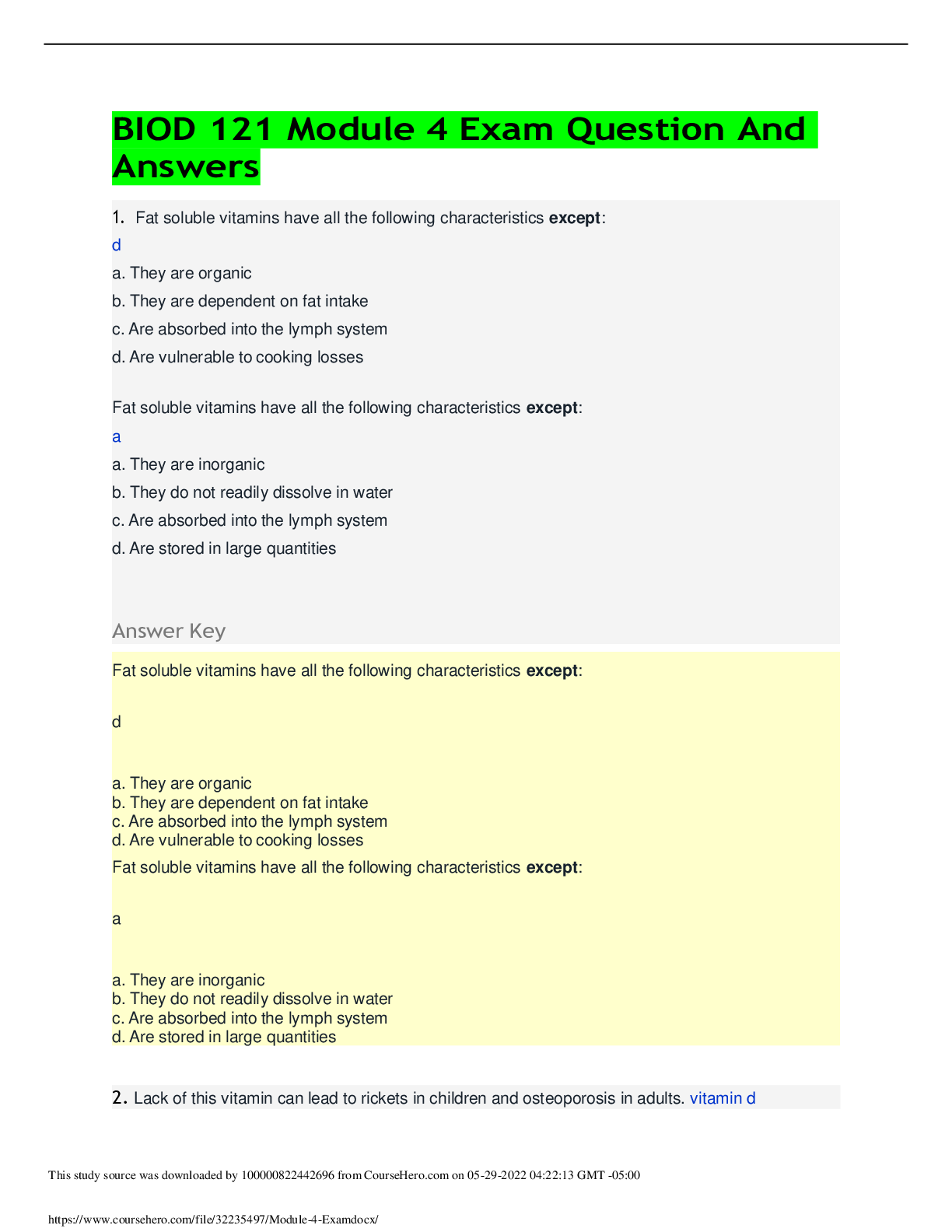
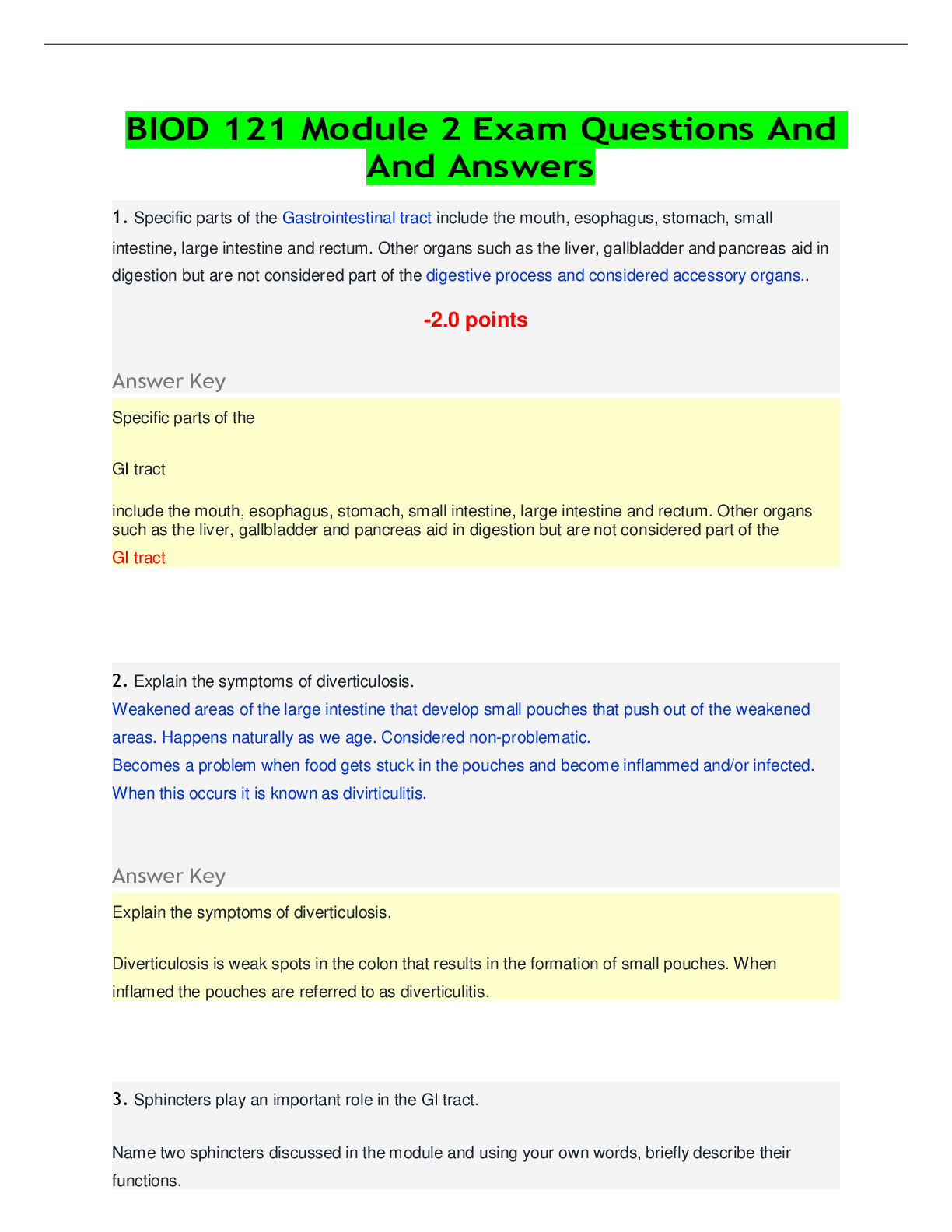

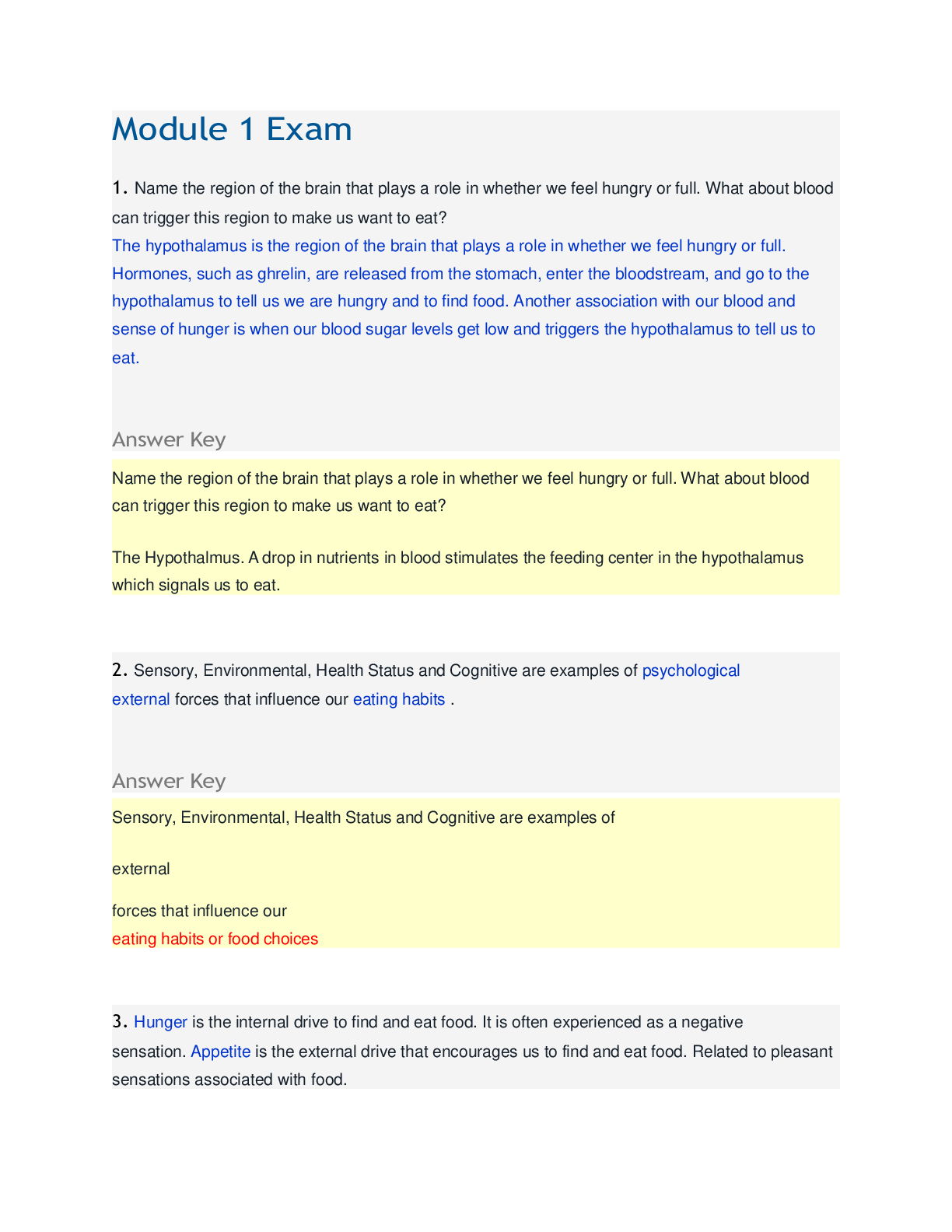
 (1).png)
 (1).png)
 (1).png)
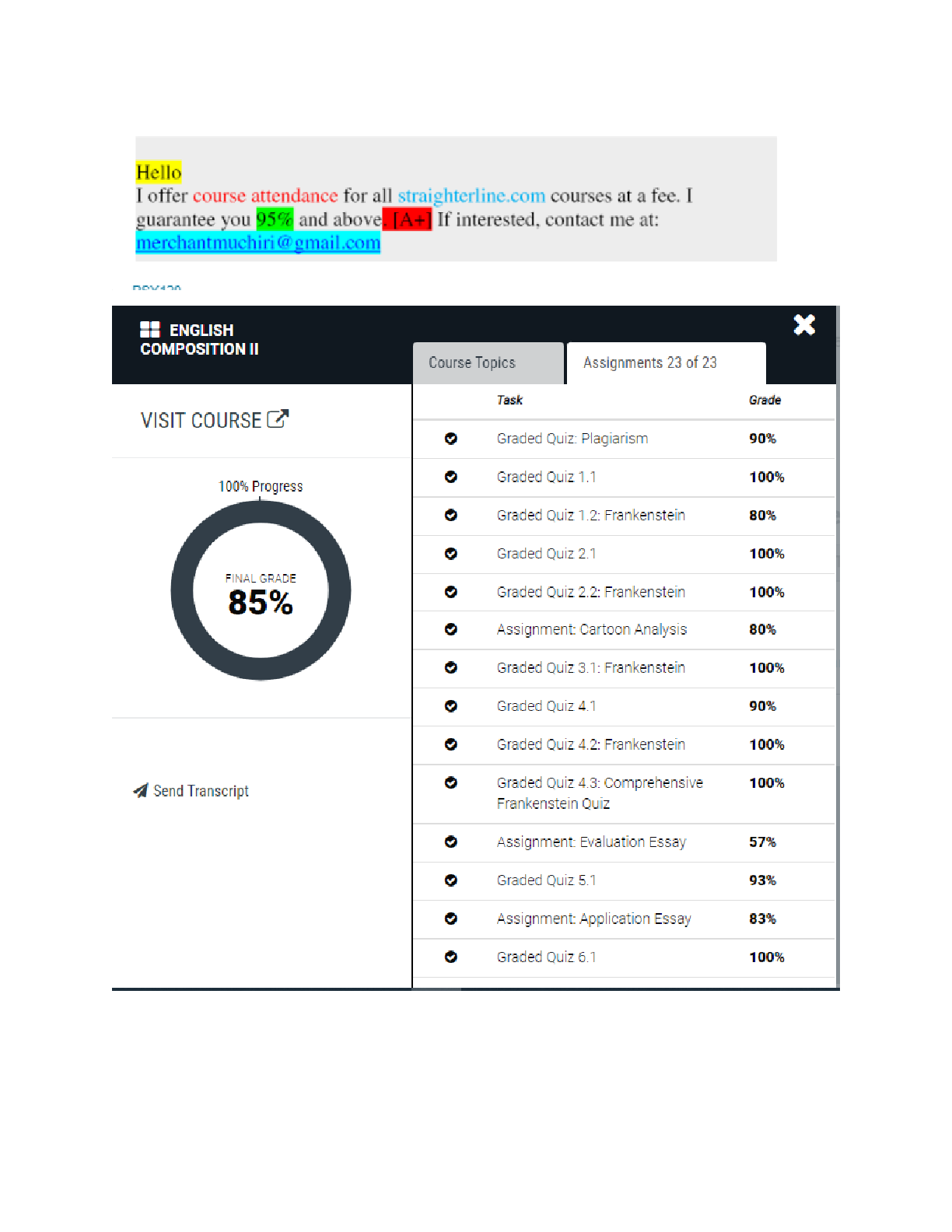

.png)


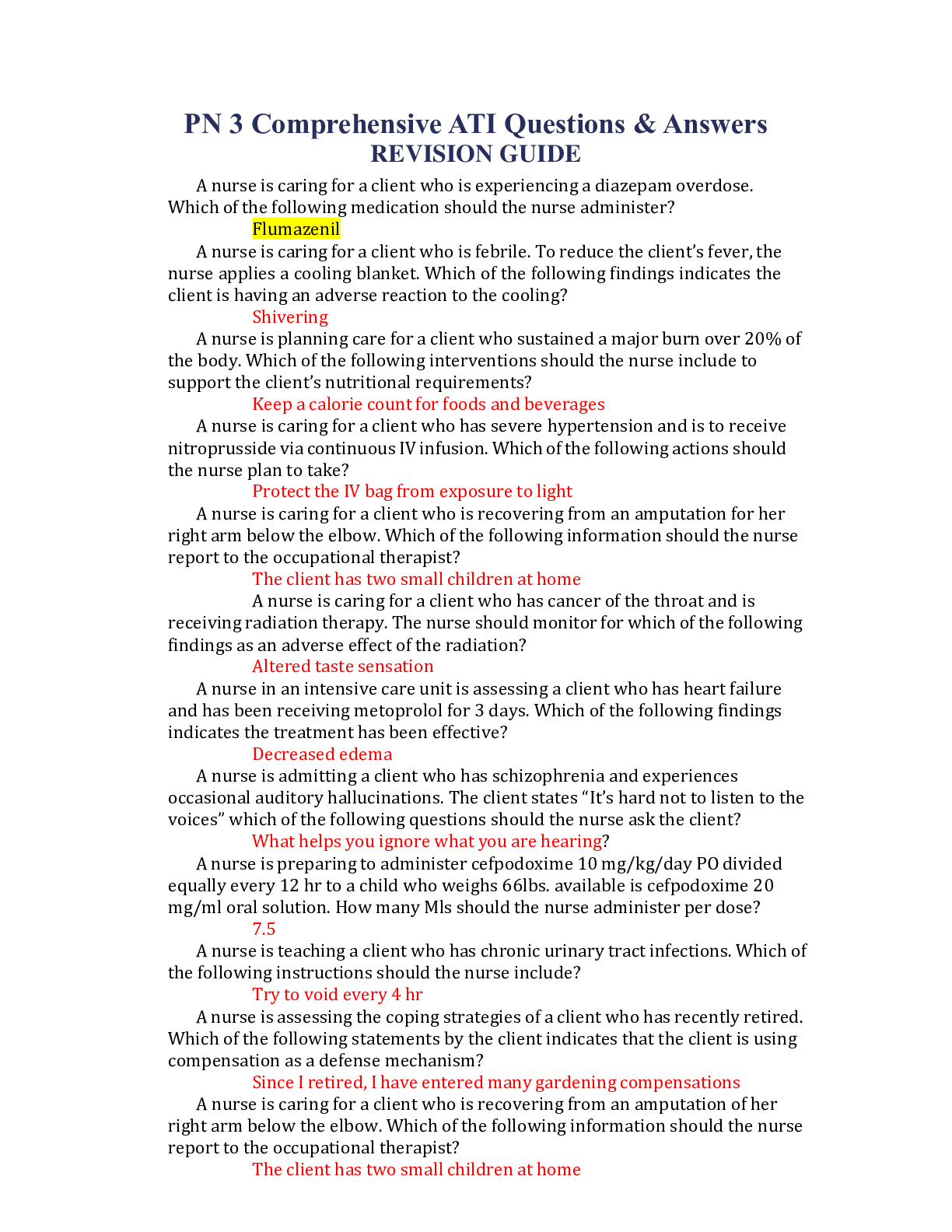
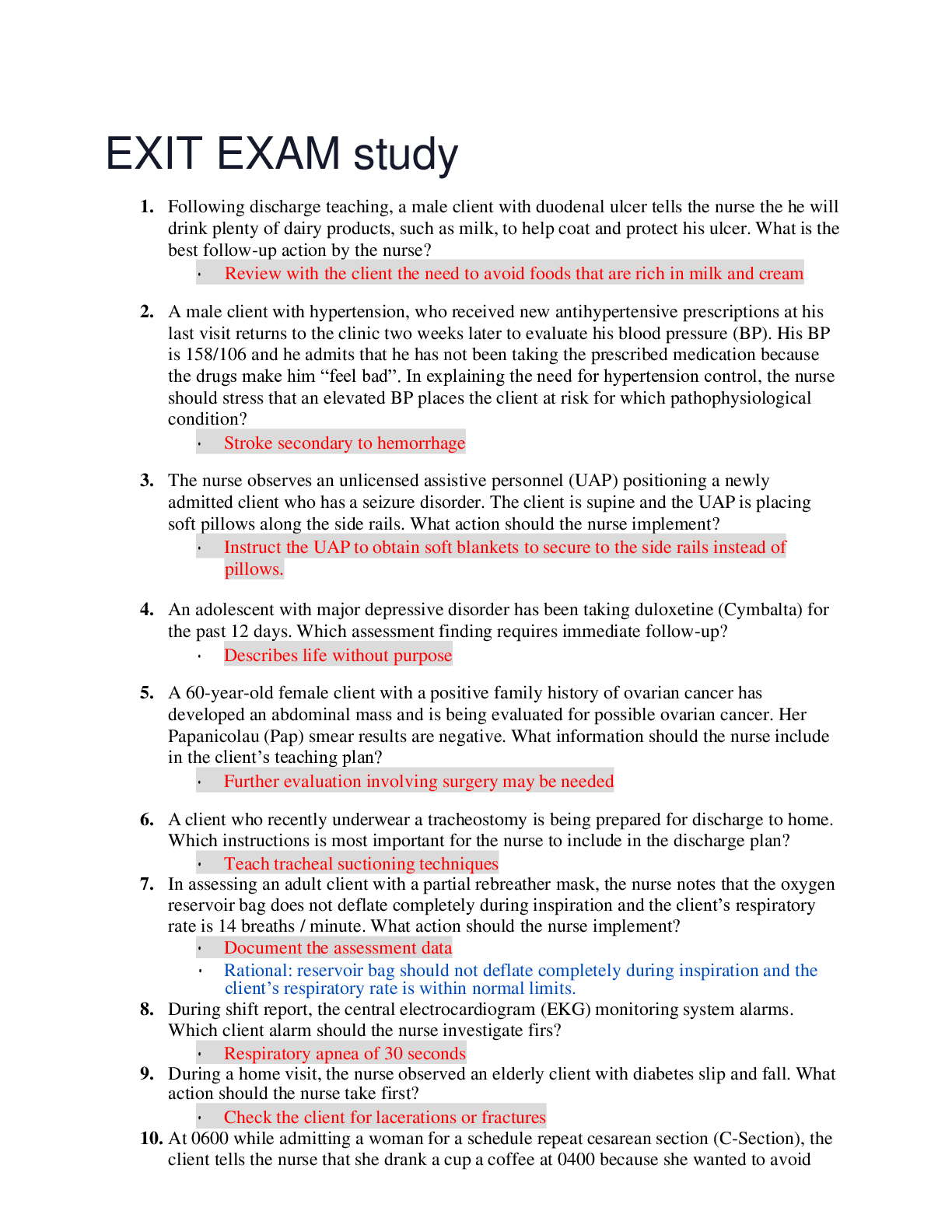
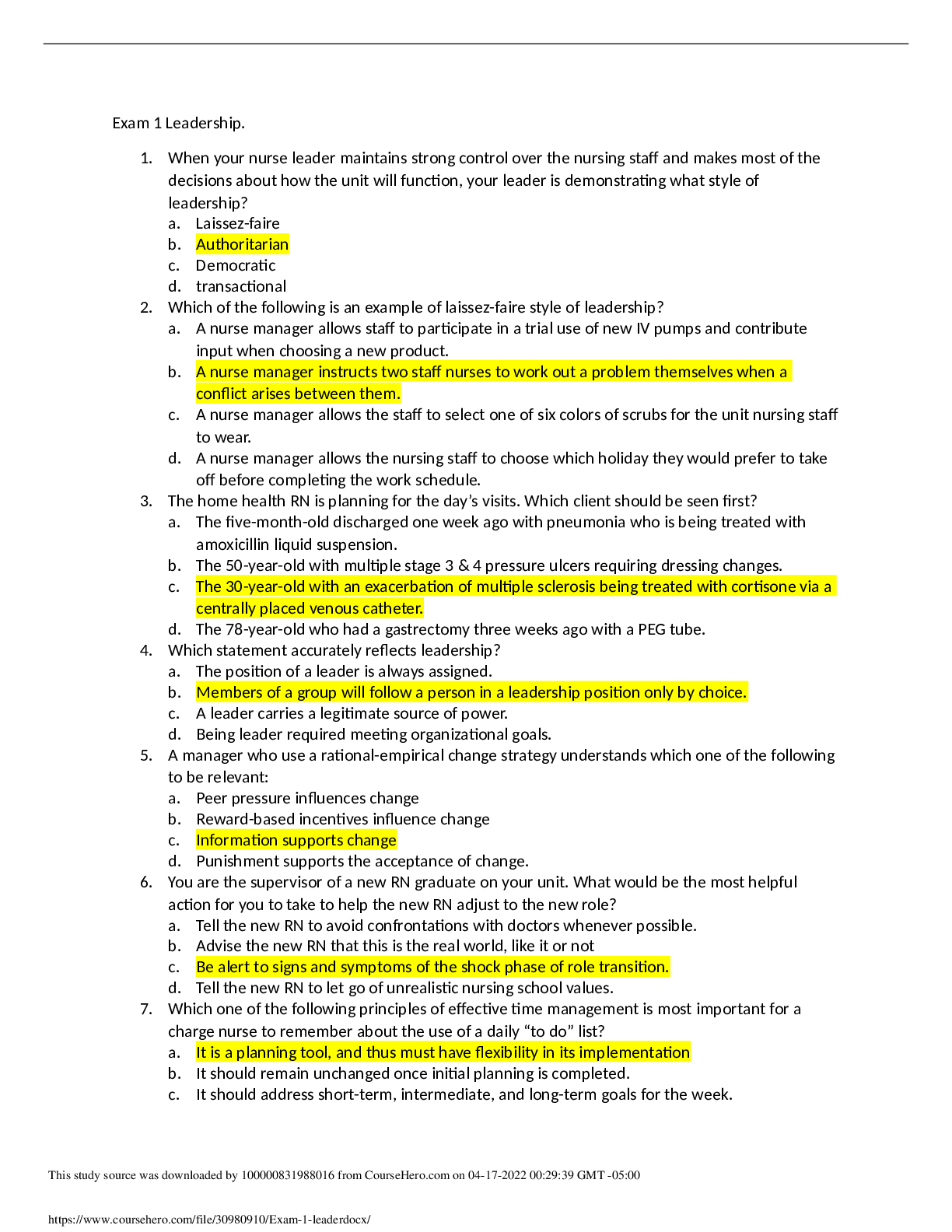
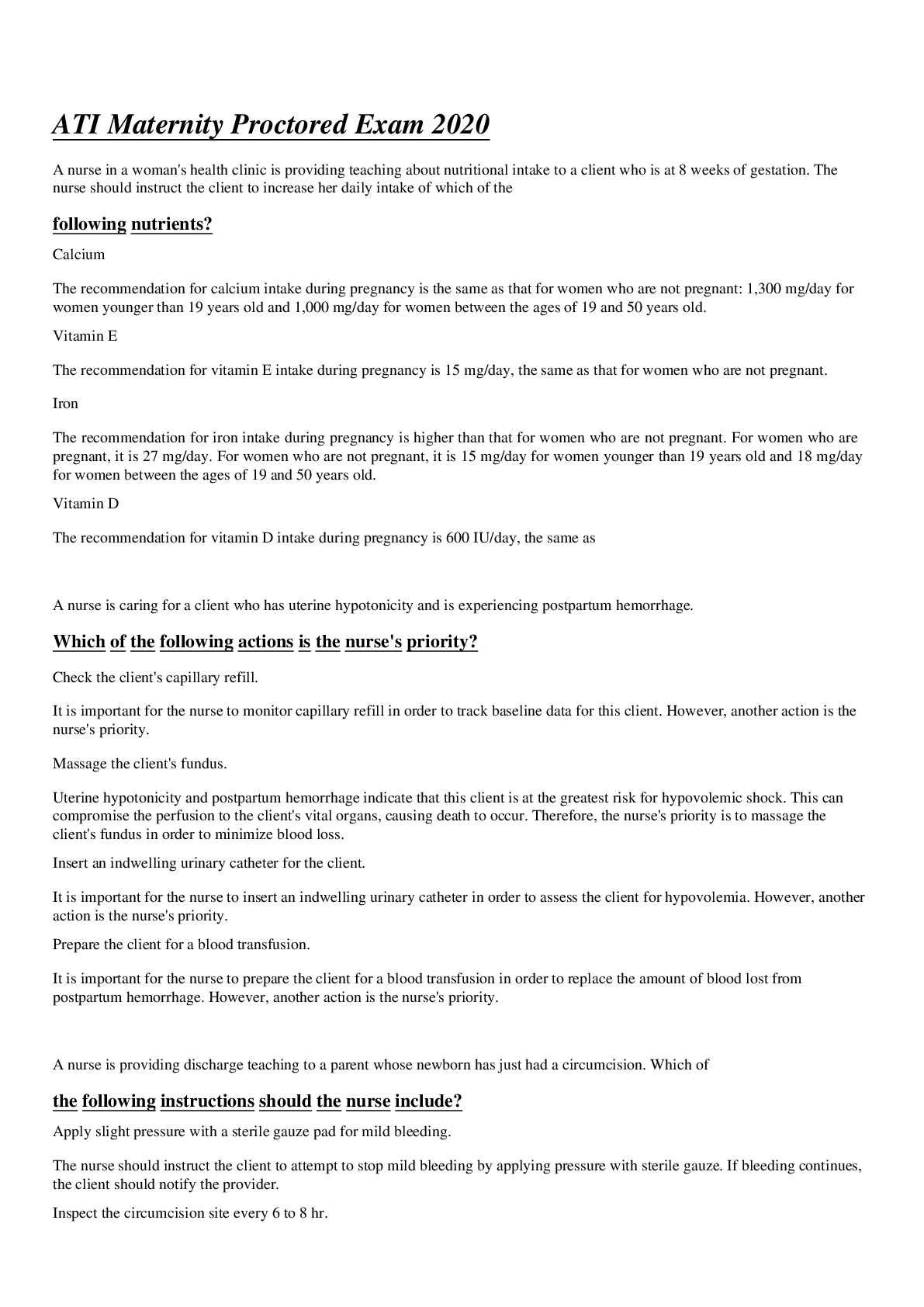
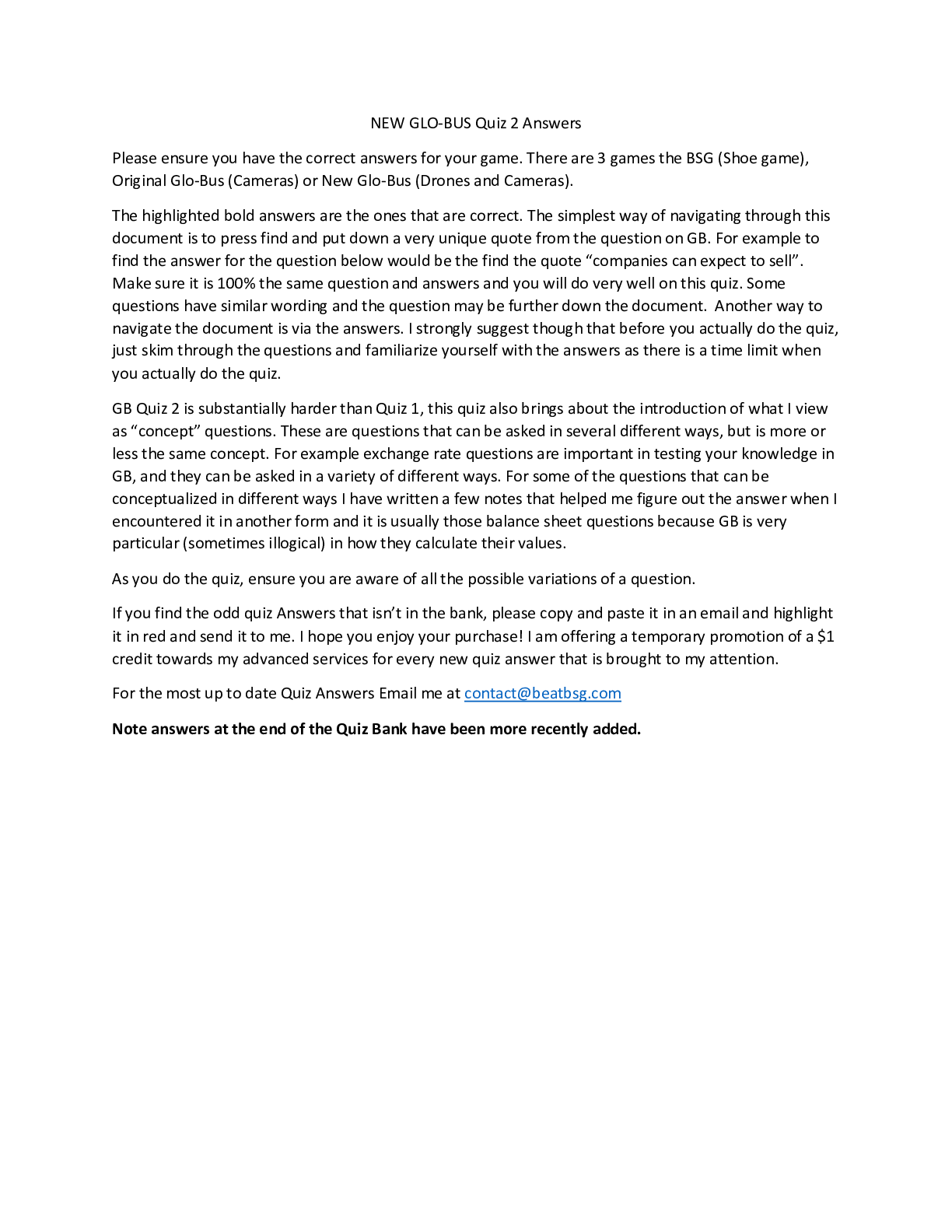
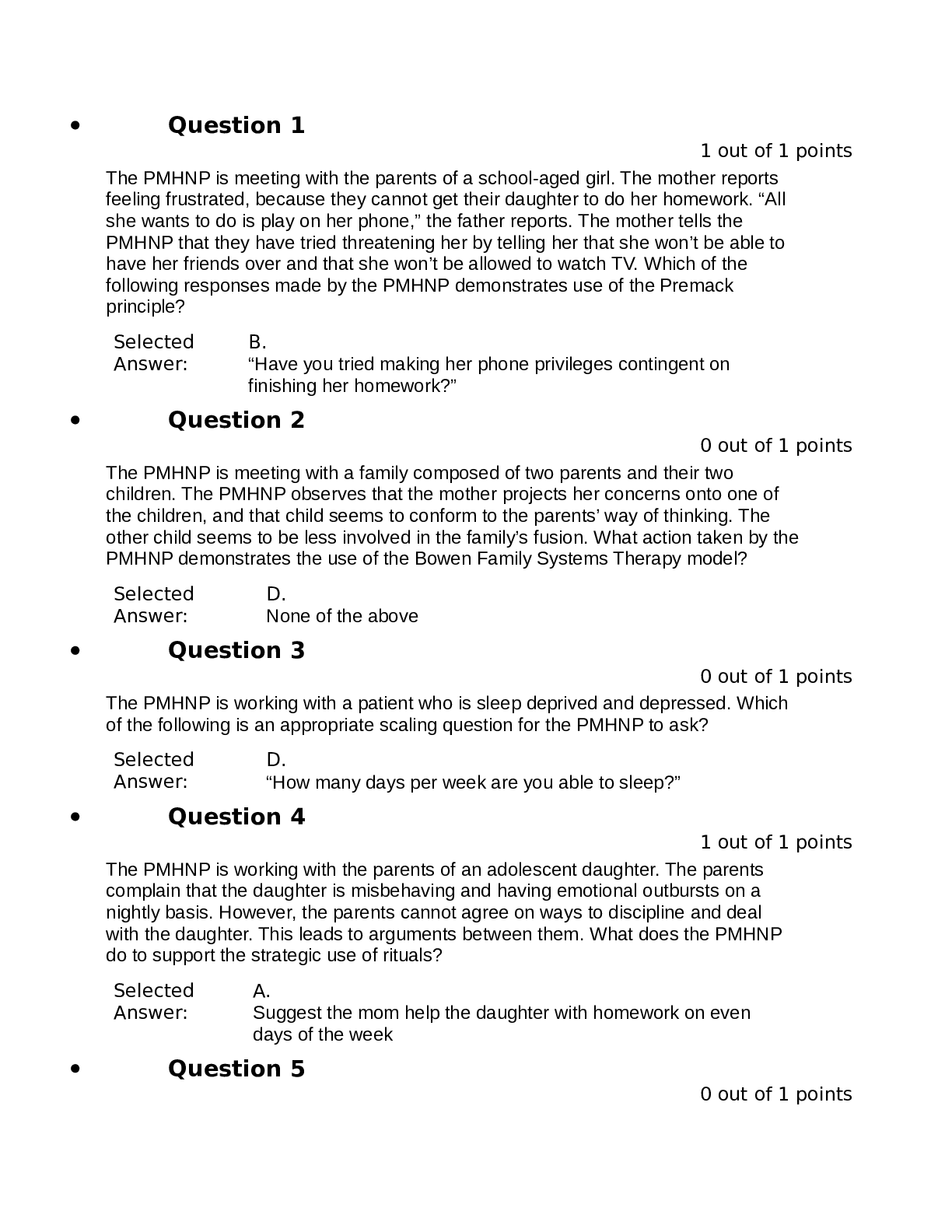
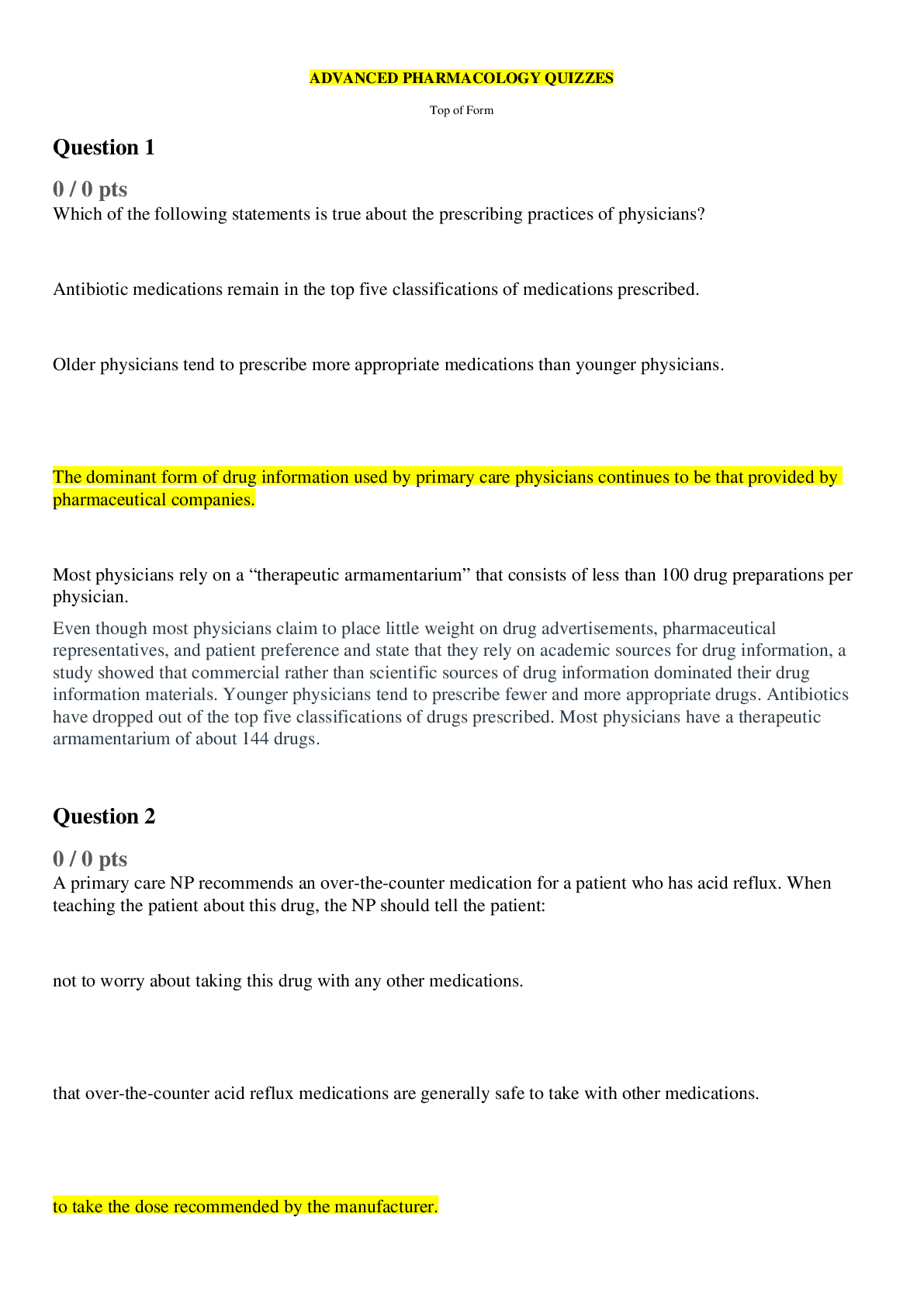
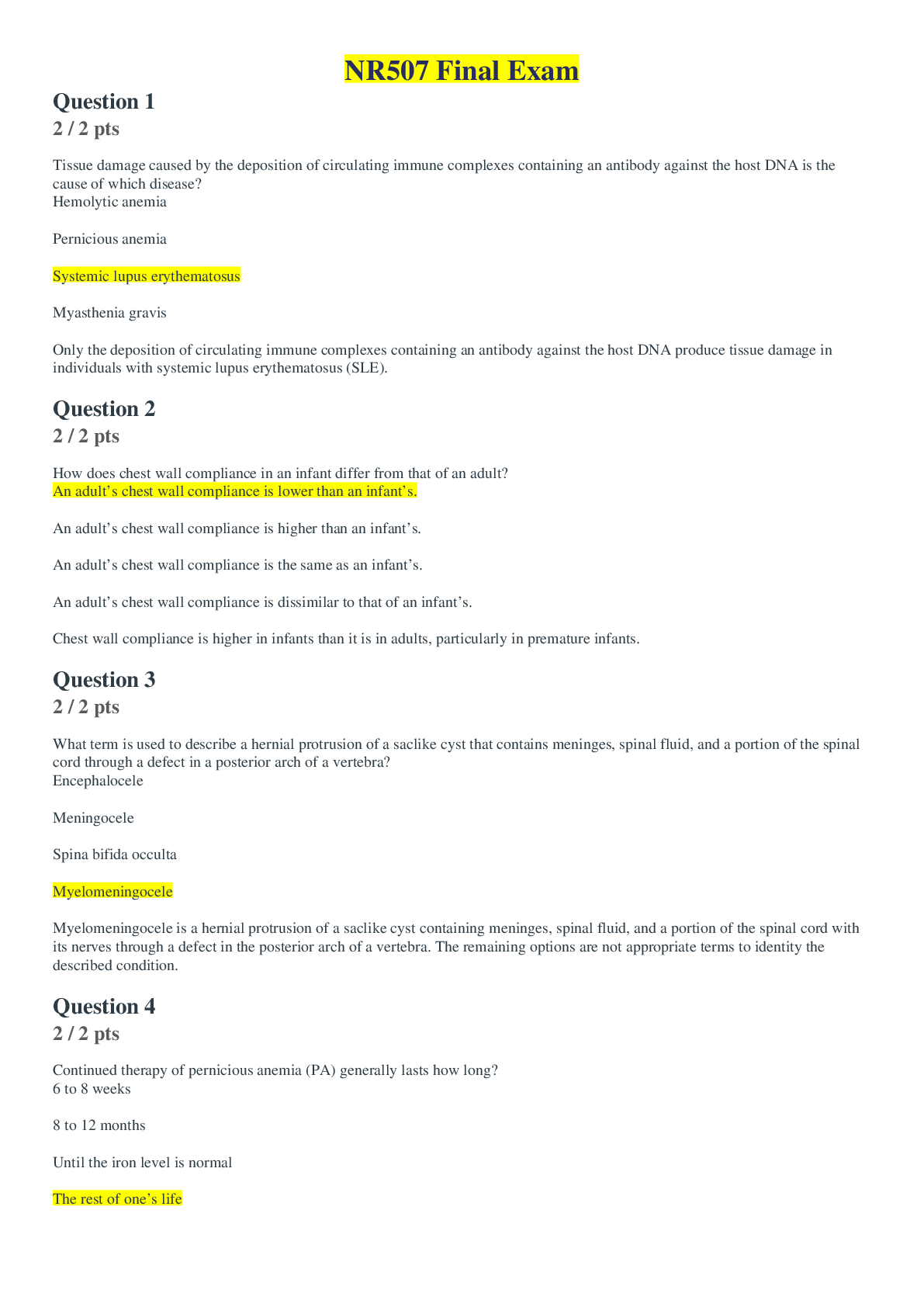
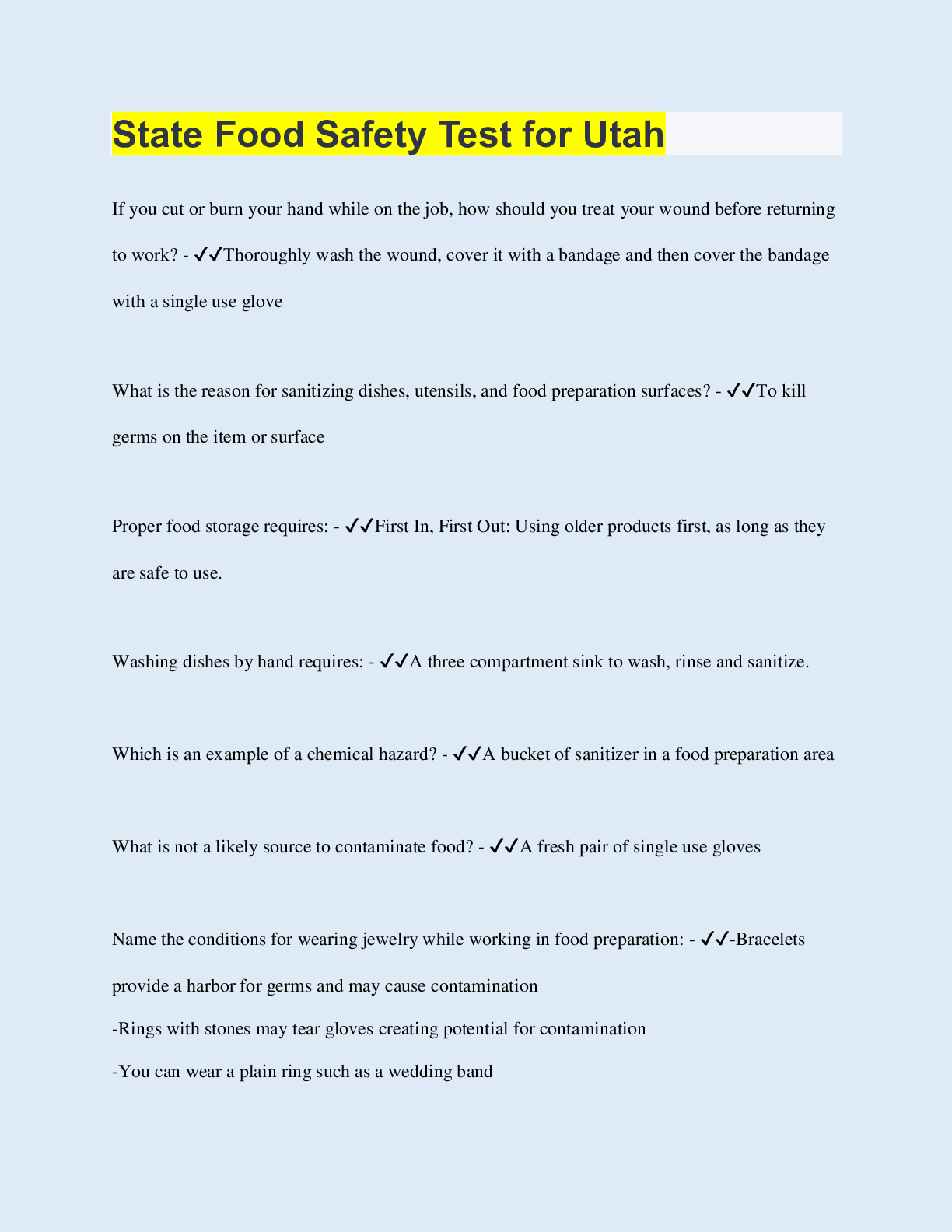

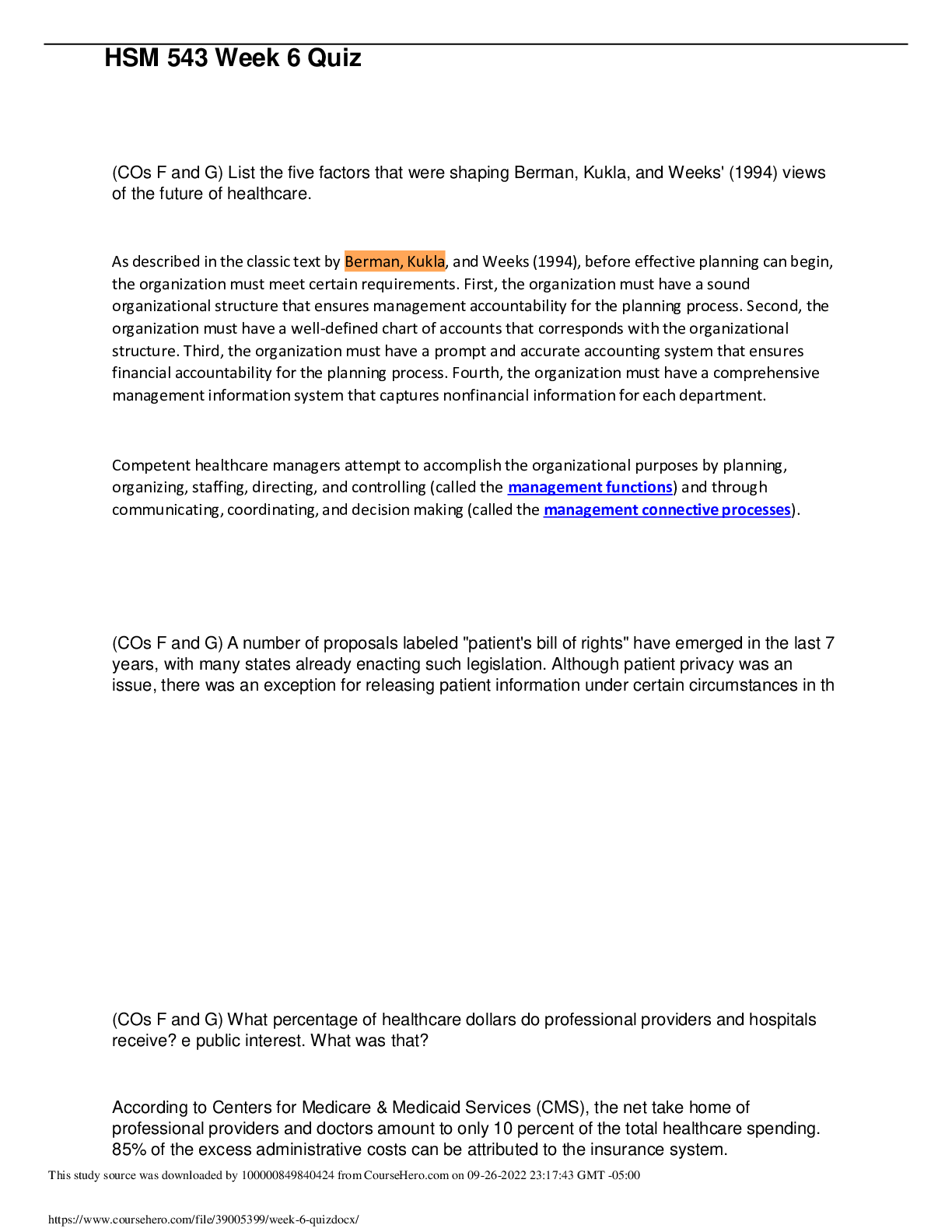
 (1).png)

.png)

